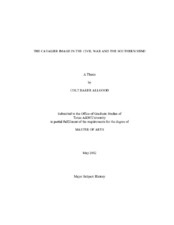| dc.description.abstract | This thesis examines the methods and actions of selected Virginians who chose to adopt irregular tactics in wartime, and focuses on the reasons why they fought that way. The presence of the Cavalier image in Virginia had a direct impact on the military exploits of several cavalry officers in both the Revolutionary War and the American Civil War. The Royalist cavalry during the English Civil War gave rise to the original Cavalier image, but as migrants came to Virginia during the seventeenth and eighteenth centuries, the image became a general term for the Southern planter. This thesis contends that selected Virginia cavalry officers attempted to adhere to an Americanized version of the Cavalier image. They either purposefully embodied aspects of the Cavalier image during their military service, or members of the Southern populace attached the Cavalier image to them in the post-war period. The Cavalier thus served as a military ideal, and some cavalry officers represented a romanticized version of the Southern martial hero.
This thesis traces the development of the Cavalier image in Virginia chronologically. It focuses on the origins of the Cavalier image and the role of the Royalist cavalry during the English Civil War. After the Royalist migration, and especially during the American Revolution, Virginians like Henry Lee embodied aspects of the Cavalier image during their military careers. Between the end of the American Revolution and the beginning of the Civil War, some Southern authors perpetuated the image by including Cavalier figures in many of their literary works. In the Civil War, select Virginians who fought for the Confederacy personified the Cavalier hero in the minds of many white Southerners. Despite a Confederate defeat, the Cavalier image persisted in Southern culture in the post-Civil War period and into the twentieth century. | en |


